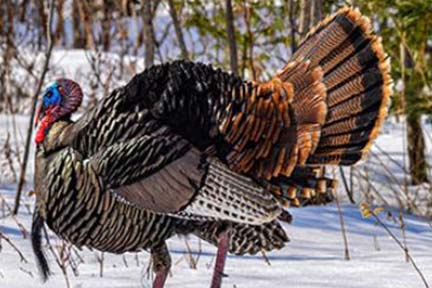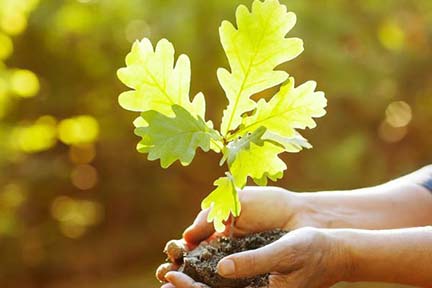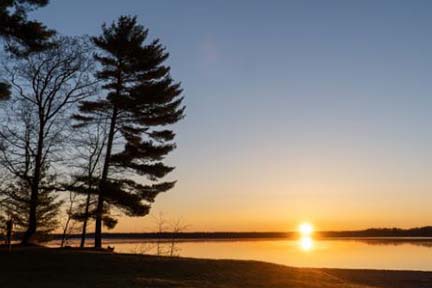Oct. 23, 2024
Contact: Kerry Gray, 734-691-1806
DNR announces $3 million in grants to help 19 Michigan communities expand and enhance trees and green space
 Projects such as community engagement and tree planting in Morenci and Portage and youth training and education in Detroit are among those sharing about $3 million in Michigan Department of Natural Resources Urban and Community Forestry Inflation Reduction Act grants recently awarded to Michigan communities and organizations. Projects such as community engagement and tree planting in Morenci and Portage and youth training and education in Detroit are among those sharing about $3 million in Michigan Department of Natural Resources Urban and Community Forestry Inflation Reduction Act grants recently awarded to Michigan communities and organizations.
The UCF IRA grant program is made possible through money provided by the USDA Forest Service’s Urban and Community Forestry Program and the Inflation Reduction Act of 2022.
Trees play an essential role in improving the quality of life for Michigan residents. They improve air quality, lower summer temperatures, reduce energy costs and help manage the flow of stormwater. Trees enhance people’s mental and physical well-being and help reduce the effects of climate change, creating healthier and more resilient communities.
“This program provides vital funding to help disadvantaged Michigan communities sustainably grow, care for and manage their public trees,” said Kerry Gray, grant coordinator for the program. “This helps ensure that trees and the essential benefits they provide are available to more people in more communities.”
A total of 40 applications requesting nearly $6.7 million from Michigan communities were received.
The 19 awards to communities around the state will collectively plant and care for more than 2,800 trees, train 3,200 city staff, students and residents, and inventory and develop plans to sustainably manage over 157,000 public trees benefiting more than 769,500 Michigan residents. |
Funding a variety of projects
All projects occur in or directly benefit disadvantaged Michigan communities and include community engagement activities. The following projects received funding:
City of Alpena: $160,000 to complete a public tree inventory and management plan to guide project tree planting and maintenance activities.
Chippewa Luce Mackinac Conservation District: $142,495 for tree planting and volunteer engagement in several eastern Upper Peninsula communities.
Detroit River Project: $219,568 for youth education and training and tree planting and care.
Grand Valley Metro Council: $206,359 for volunteer engagement and tree planting in the city of Wyoming based on the results of a tree canopy assessment and planting plan.
City of Hazel Park: $147,620 to complete a public tree inventory and maintenance plan to guide project tree planting activities.
Kent County Parks and Recreation: $56,885 for youth training, park tree inventory and management plan at three county parks.
Manistee Conservation District: $224,301 to complete a public tree inventory and management plan to guide project tree planting and maintenance activities.
City of Marshall: $102,400 to complete a public tree inventory and management plan to guide project tree planting, removal and maintenance activities.
City of Midland: $225,000 to complete a public tree inventory to guide project tree planting activities.
City of Morenci: $218,165 for tree planting, volunteer engagement, and outreach, education and training.
Michigan State University Department of Forestry: $225,000 to develop and implement a two-year Urban Forest Management certificate program through Michigan State University’s Institute of Agricultural Technology at the MSU-Detroit Partnership for Food, Learning and Innovation.
Oakland County Parks and Recreation: $100,000 for tree planting and park tree inventories in select county parks.
City of Portage: $150,000 for volunteer engagement and public tree planting to replace trees lost to storm damage.
Presque Isle Conservation District: $197,157 for public tree planting, tree removal, volunteer engagement and city staff training in Rogers City and Onaway.
City of River Rouge: $71,000 for tree planting at Belanger Park following U.S. Environmental Protection Agency clean-up at the park.
Village of Romeo: $20,900 for a public tree inventory and maintenance plan.
City of Roseville: $101,600 for city staff training, tree planting and a public tree inventory and management plan.
City of Warren: $190,000 to complete a public tree inventory and management plan to guide project tree planting and maintenance activities.
West Michigan Shoreline Regional Development Commission: $225,000 to complete a public tree inventory and management plan to guide project tree planting and maintenance activities in Muskegon.
More info and future oportunities
The UCF IRA Grant program will release applications for the final round of funding in early 2025.
Under the Inflation Reduction Act, the USDA Forest Service Urban and Community Forestry program received a historic $1.5 billion to support tree-planting, urban forest planning and management, and related activities, particularly in disadvantaged communities. To date, the agency has invested over $1.3 billion in grant projects submitted by entities that are working to increase equitable access to trees and green spaces and the many benefits they provide. For more information, visit the USFS UCF Inflation Reduction Act website.
The Michigan DNR Urban and Community Forestry Program is a federally funded program providing technical, educational and grant assistance to communities, nonprofits, educational institutions and tribes to build capacity for managing trees and forests in communities throughout the state. |




 Calling all fans of Michigan’s state parks and recreation areas! You’re invited to the special two-part “Inside Michigan State Parks” webinar series highlighting a few of the exciting projects in the works around the state.
Calling all fans of Michigan’s state parks and recreation areas! You’re invited to the special two-part “Inside Michigan State Parks” webinar series highlighting a few of the exciting projects in the works around the state.
 Did you know that turkeys not only gobble, they also cluck and purr? And in addition to flying, wild turkeys can even swim when they need to! Thanks to collaborative conservation, these incredible birds are thriving across Michigan.
Did you know that turkeys not only gobble, they also cluck and purr? And in addition to flying, wild turkeys can even swim when they need to! Thanks to collaborative conservation, these incredible birds are thriving across Michigan.
 Michiganders can help by volunteering with the DNR on
Michiganders can help by volunteering with the DNR on  While we don’t yet know what winter has in store, state-designated snowmobile trails are open Dec. 1 to March 31, and trail grooming occurs when there is enough snow on the ground. Now is a good time to prep for the season (think snow!), starting with purchasing your snowmobile trail permit.
While we don’t yet know what winter has in store, state-designated snowmobile trails are open Dec. 1 to March 31, and trail grooming occurs when there is enough snow on the ground. Now is a good time to prep for the season (think snow!), starting with purchasing your snowmobile trail permit.
 Here is ride-related info to keep in mind:
Here is ride-related info to keep in mind:
 Now that most trees across the state have dropped their leaves, tree maintenance may not be top of mind. When it comes to your oak trees, however, you might want to reconsider!
Now that most trees across the state have dropped their leaves, tree maintenance may not be top of mind. When it comes to your oak trees, however, you might want to reconsider!
 See more pictures by
See more pictures by 

 If you’re out and about shopping over the next few weeks, consider donating to the annual Stuff a Truck holiday toy collections. The drive, now in its sixth year, is hosted by Michigan Department of Natural Resources conservation officers and will take place at several locations throughout the Lower Peninsula.
If you’re out and about shopping over the next few weeks, consider donating to the annual Stuff a Truck holiday toy collections. The drive, now in its sixth year, is hosted by Michigan Department of Natural Resources conservation officers and will take place at several locations throughout the Lower Peninsula.

 Tree planting, education about the benefits of trees and other tree-centric efforts are on tap in nine Michigan communities thanks to Community Forestry Grants from the Michigan Department of Natural Resources. Those communities will share $127,093 in grant funding.
Tree planting, education about the benefits of trees and other tree-centric efforts are on tap in nine Michigan communities thanks to Community Forestry Grants from the Michigan Department of Natural Resources. Those communities will share $127,093 in grant funding.


 Just in time for firearm deer season, the DNR Wildlife Division’s
Just in time for firearm deer season, the DNR Wildlife Division’s  Michigan welcomed some rare owls to the Upper Peninsula this fall, a trend that is likely to continue as northern owls migrate south into Michigan for the winter. At the end of September, a burrowing owl (like those pictured here) was seen at Whitefish Point, on the northern tip of Chippewa County, for the first time since 1986! This sighting is one of only four known records in Michigan.
Michigan welcomed some rare owls to the Upper Peninsula this fall, a trend that is likely to continue as northern owls migrate south into Michigan for the winter. At the end of September, a burrowing owl (like those pictured here) was seen at Whitefish Point, on the northern tip of Chippewa County, for the first time since 1986! This sighting is one of only four known records in Michigan.
 Ready to kickstart your 2025? Turn to the outdoors and help honor Michigan’s history by signing up for three 5K run/walk events. Registration is now open for the:
Ready to kickstart your 2025? Turn to the outdoors and help honor Michigan’s history by signing up for three 5K run/walk events. Registration is now open for the:
 November is a great time for birding as species like the sandhill crane are migrating through Michigan, but birders are urged to be aware of another season that is underway: hunting.
November is a great time for birding as species like the sandhill crane are migrating through Michigan, but birders are urged to be aware of another season that is underway: hunting.
 Does your perfect snowy day include hitting the trails with your sled? Are you interested in helping protect the state’s thousands of miles of snowmobile routes? Here’s an opportunity to work alongside DNR staff to help maintain and protect more than 6,000 miles of DNR-designated snowmobile trails, public roads and public lands open to snowmobiling (where authorized).
Does your perfect snowy day include hitting the trails with your sled? Are you interested in helping protect the state’s thousands of miles of snowmobile routes? Here’s an opportunity to work alongside DNR staff to help maintain and protect more than 6,000 miles of DNR-designated snowmobile trails, public roads and public lands open to snowmobiling (where authorized).
 Whether you’re a longtime hunter or someone just getting started in this outdoor tradition, November is an excellent time to check out Michigan’s options. We’ve got everything from snowshoe hare, ruffed grouse and gray squirrel to turkey, raccoon and coyote – plus a variety of trapping opportunities, such as badger, beaver and muskrat.
Whether you’re a longtime hunter or someone just getting started in this outdoor tradition, November is an excellent time to check out Michigan’s options. We’ve got everything from snowshoe hare, ruffed grouse and gray squirrel to turkey, raccoon and coyote – plus a variety of trapping opportunities, such as badger, beaver and muskrat.
 See more pictures by
See more pictures by 
 Projects such as community engagement and tree planting in Morenci and Portage and youth training and education in Detroit are among those sharing about $3 million in Michigan Department of Natural Resources Urban and Community Forestry Inflation Reduction Act grants recently awarded to Michigan communities and organizations.
Projects such as community engagement and tree planting in Morenci and Portage and youth training and education in Detroit are among those sharing about $3 million in Michigan Department of Natural Resources Urban and Community Forestry Inflation Reduction Act grants recently awarded to Michigan communities and organizations.